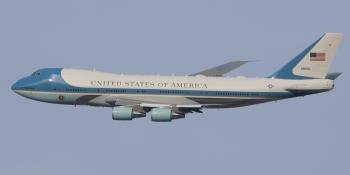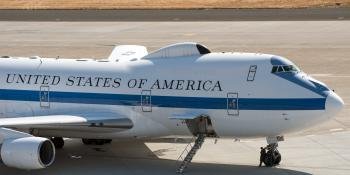The US Air Force’s (USAF’s) four-strong fleet of Boeing E-4B Nightwatch airborne command and control (C2) aircraft is receiving key upgrades that are designed to revolutionise the platform’s communication capabilities and effectiveness.
The service revealed on March 4 that the first of four E-4Bs had successfully completed the upgrade process, as well as an associated developmental testing programme. During the upgrade, the aircraft received Low Frequency Transmit System (LFTS) and Advanced Extremely High Frequency Presidential National Voice Conferencing Integration Program (APIP) modifications. Boeing and Collins Aerospace are working on installing the LFTS, while Raytheon Technologies is responsible for integrating the APIP modifications onto the aircraft.
![E-4B Nightwatch [USAF/Staff Sgt Nicole Leidholm]](https://fullfatthings-keyaero.b-cdn.net/sites/keyaero/files/inline-images/Boeing%20E-4B%20Nightwatch%20%5BUSAF%20-%20Staff%20Sgt%20Nicole%20Leidholm%5D%201.jpg)
The USAF states that two directorates formed a key part of this upgrade effort. The Air Force Nuclear Weapons Center’s Nuclear Command, Control and Communications Directorate was responsible for acquiring the APIP systems through two programmatic efforts and served as technical advisors while the system performance was verified. The Command, Control, Communication, Intelligence, and Networks Directorate was responsible for escorting, securing and transferring crypto materials that were vital to the evaluation, testing and operation of the E-4B’s communication systems.
Lt Col Ben Chown, E-4B Materiel Leader for the Presidential and Executive Airlift Directorate (which is leading the upgrade effort), said: “These modifications are game changing. The LFTS modification provides [a] revolutionary single wire low frequency communication capability, while APIP transforms [the] reliability and survivability of the E-4B SATCOM and national leadership C2 systems. The team is phenomenal at what they do! Their dedication to the E-4B mission ensured [the] successful accomplishment of these modifications, enabling a strategic advantage for the warfighter.”
The USAF adds that the three remaining E-4Bs will be upgraded during their standard programmed depot maintenance cycles over the next few years, allowing the service to maximise the fleet’s operational availability.
![E-4B Nightwatch [USAF/Staff Sgt Jacob Skovo]](https://fullfatthings-keyaero.b-cdn.net/sites/keyaero/files/inline-images/Boeing%20E-4B%20Nightwatch%20%5BUSAF%20-%20Staff%20Sgt%20Jacob%20Skovo%5D%201.jpg)
Colloquially known as the “Doomsday” plane, the E-4B is a specially-modified, militarised variant of Boeing’s 747-200B commercial aircraft, which began operations with the USAF in 1980. The platform serves as a National Airborne Operations Center (NAOC) and is a key, well-established component of the US’ National Military Command System.
In this role, the E-4B is employed as an airborne command, control and communication (C3) centre that is able to direct military forces and civil authorities during the event of a national emergency. The USAF’s four-strong fleet of Nightwatch aircraft are operated by the 1st Airborne Command and Control Squadron (ACCS) from Offutt Air Force Base (AFB) in Nebraska. However, the fleet is operating from nearby Lincoln Airport for the next 18 months as runway replacement work takes place at Offutt AFB.
Despite this ongoing modification process, the USAF has launched its Survivable Airborne Operations Center (SAOC) programme, which seeks to source a new platform to carry on the service's NAOC mission and ultimately replace the air arm's matured fleet of E-4Bs. While the requirements for the SAOC programme remain highly classified, the USAF has publicly noted that it aspires to select a platform that is of a similar size and layout when compared to the 747-200B that the Nightwatch platforms are based on.


![Boeing E-4B Nightwatch [USAF/SA Mary O'Dell] Thumbnail](https://fullfatthings-keyaero.b-cdn.net/sites/keyaero/files/styles/listing_card/public/2019-12/1258180.jpg?h=3d1dfa67&itok=EPTUmblm)


